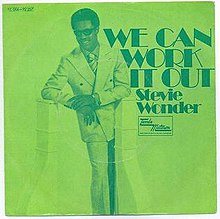We Can Work It Out
| "We Can Work It Out" | |||||||||||||||||
|---|---|---|---|---|---|---|---|---|---|---|---|---|---|---|---|---|---|

US picture sleeve
|
|||||||||||||||||
| Single by The Beatles | |||||||||||||||||
| A-side | "Day Tripper" | ||||||||||||||||
| Released | 3 December 1965 | ||||||||||||||||
| Format | 7" | ||||||||||||||||
| Recorded | 20 and 29 October 1965 EMI Studios, London |
||||||||||||||||
| Genre | Folk rock | ||||||||||||||||
| Length | 2:15 | ||||||||||||||||
| Label | Parlophone (UK), Capitol (US) | ||||||||||||||||
| Writer(s) | Lennon–McCartney | ||||||||||||||||
| Producer(s) | George Martin | ||||||||||||||||
| The Beatles UK singles chronology | |||||||||||||||||
|
|||||||||||||||||
|
|||||||||||||||||
| "Exposition/We Can Work It Out" | ||||
|---|---|---|---|---|
| Song by Deep Purple from the album The Book of Taliesyn | ||||
| Released | December 1968 | |||
| Recorded | August 1968 | |||
| Genre | Progressive rock, psychedelic rock, hard rock | |||
| Length | 7:06 | |||
| Label |
Harvest Records (UK) Tetragrammaton (US) |
|||
| Writer(s) |
Beethoven, Ritchie Blackmore, Nick Simper, Jon Lord, Ian Paice Lennon–McCartney |
|||
| Producer(s) | Derek Lawrence | |||
| The Book of Taliesyn track listing | ||||
|
||||
| "We Can Work It Out" | ||||
|---|---|---|---|---|
 |
||||
| Single by Stevie Wonder | ||||
| from the album Signed, Sealed & Delivered | ||||
| B-side | "Never Dreamed You'd Leave in Summer" | |||
| Released | March 1971 | |||
| Genre | R&B | |||
| Length | 3:19 | |||
| Label | Tamla | |||
| Writer(s) | Lennon–McCartney | |||
| Producer(s) | Stevie Wonder | |||
| Stevie Wonder singles chronology | ||||
|
||||
"We Can Work It Out" is a song by the English rock band the Beatles, written by Paul McCartney and John Lennon. It was first issued as a double A-side single with "Day Tripper" in December 1965. The release marked the first time that both tracks on a Beatles single were designated as joint A-sides. The song was recorded during the sessions for the band's Rubber Soul album.
"We Can Work It Out" is a comparatively rare example of a Lennon–McCartney collaboration from this period in the Beatles' career, in that it recalls the level of collaboration the two songwriters had shared when writing the group's hit singles of 1963. This song, "A Day in the Life", "Baby, You're a Rich Man" and "I've Got a Feeling", are among the notable exceptions.
McCartney wrote the words and music to the verses and the chorus, with lyrics that "might have been personal", probably a reference to his relationship with Jane Asher. McCartney then took the song to Lennon:
I took it to John to finish it off, and we wrote the middle together. Which is nice: 'Life is very short. There's no time for fussing and fighting, my friend.' Then it was George Harrison's idea to put the middle into 3/4 time, like a German waltz. That came on the session, it was one of the cases of the arrangement being done on the session.
With its intimations of mortality, Lennon's contribution to the twelve-bar bridge contrasts typically with what Lennon saw as McCartney's cajoling optimism, a contrast also seen in other collaborations by the pair, such as "Getting Better" and "I've Got a Feeling". As Lennon told Playboy in 1980:
In We Can Work It Out, Paul did the first half, I did the middle eight. But you've got Paul writing, 'We can work it out / We can work it out'—real optimistic, y'know, and me, impatient: 'Life is very short, and there's no time / For fussing and fighting, my friend.'
...
Wikipedia
